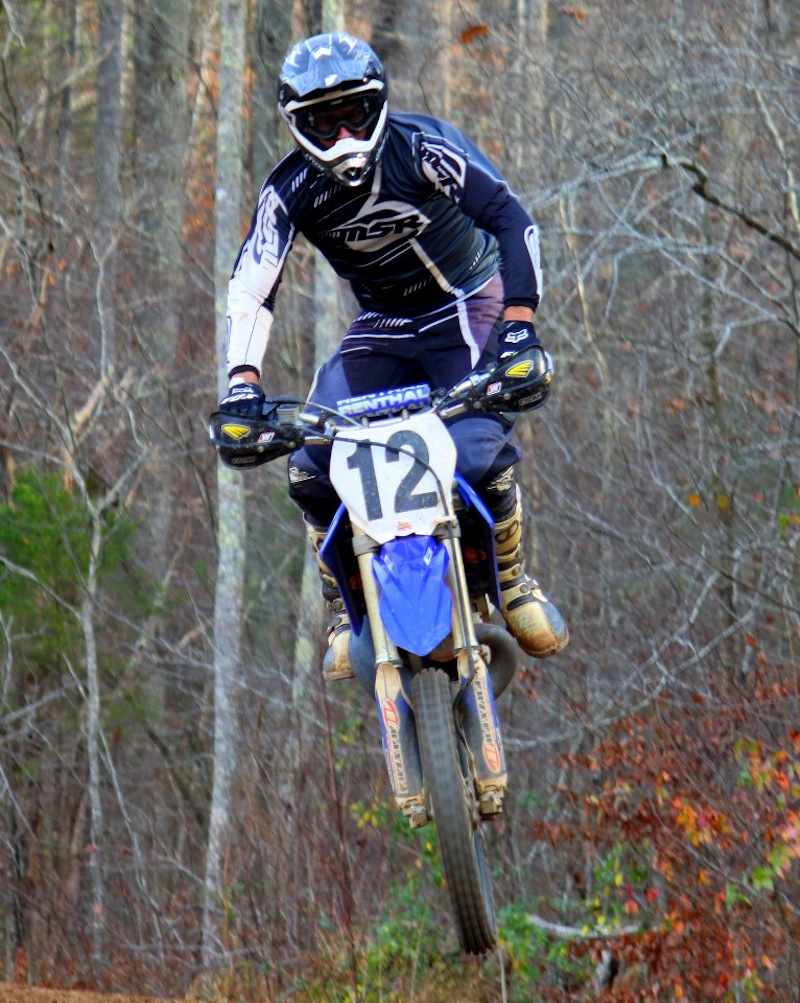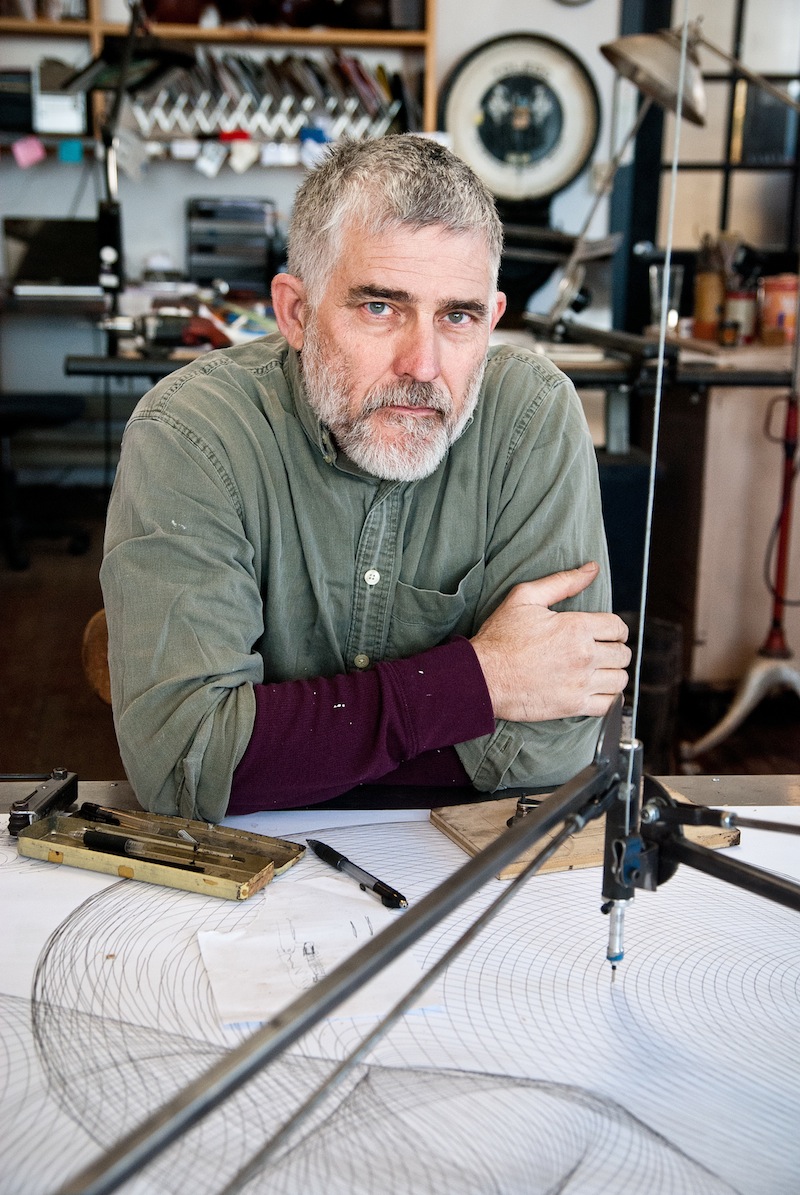
Joshe Clarke performing a jump. Photo by David Robbins

Hoss Haley with his drawing machine. Photo by Max Cooper

Tattoo artist and musician J. Horton. Photo by Max Cooper
Some of the greatest love stories are not about star-crossed lovers, but about pursuits of passion. And not romantic passion, but the sort of passion that involves waking up in the middle of the night to jot an idea in a bedside notebook. Or not sleeping at all. Or giving up everything to follow of a dream. Against all odds, and despite all obstacles. That sort of thing. Here are three such tales.
Speed dating
Joshe Clark has broken his collar bone, some ribs, an arm and “I’m on my eighth concussion,” he says. “There are times when you’re laying in the hospital bed right after you’ve been operated on or come to, when you say, ‘This isn’t worth the risk.’”
Then, two or three days out of the hospital, Clark’s thinking he needs to clean the air filters on his bike so he can ride again. Such is the siren call of motocross.
The sport of motocross — motorcycle racing on enclosed, off-road circuits — started with competitions held in the U.K. more than a century ago. Requiring athletic prowess and daring, freestyle motocross was added to the X Games in ’99. And it’s dangerous: There are, on average, three motocross deaths each year.
Clark, who lives in Old Fort, got started in the sport as a 6-year-old. He grew up on a farm with plenty of room to ride — a pastime his father was fond of. While Clark’s father didn’t race, he did take his son to watch races. “It came naturally,” says Clark. “As natural as it’s come to my kids.” His son was riding at age 3 and his daughter at 4: There’s a racing class for 4- to 6-year-olds who ride kid-size 50 cc motorcycles at speeds of up to 20 miles per hour.
“Even as a rider, if you go to a new track and there’s a big jump that you haven’t jumped yet, there’s a weird feeling in the pit of your stomach,” says Clark. “You rely on your experience. I won’t say a lot of it’s prayer, but there is some involved. You’re just hoping that what you think will work, will work.” If a rider is right, he lands it. If not, he crashes. Clark says, as a parent it’s more nerve wracking to advise his children and watch them race than it is to attempt a trick for himself.
But there’s a wholesome side to the sport, too. Clark says his parents supported his riding, as a teen, because “they knew where I was on the weekends. I was at the dirt bike track, practicing. They knew I wasn’t out raising Cain and painting overpasses. That’s what I hope for my kids.”
Clark says that 95 percent of his racing has been on the East Coast, from Pennsylvania to Florida. Most racetracks are sanctioned by the American Motorcycle Association. Clark’s favorite is Muddy Creek Raceway in Bluntville, Tenn., because of the way the jumps are laid out and the elevation changes “which are a lot of fun as a rider.” A pro rider from 2000 to ’09 (these days, younger racers are home-schooled so that they can turn professional right at age 16; a lot of injuries early on can drastically shorten a career), Clark now rides in the vet pro class, for ages 30 and older.
When a racer is trying to make money in the sport, it means riding in bad weather and on hard tracks. These days, “I just go to the ones I want to,” says Clark. He also does rider training with children.
But Clark is a long way from parking his motorcycle.“Once you get out of the speed classes, the vet classes go up 65-plus. You’d be surprised at the speed they carry,” says Clark. “I’ll ride dirt bikes as long as I can, as long as it’s physically possible.”
Mechanics of love
“To create simple shapes required complicated machinery,” says sculptor Hoss Haley. Some of his simple shapes include the large, bronze, dish-shaped fountain in Pack Square Park; the woven, stainless steel pergola over the park’s stage; and a collection of round white orbs on display at the Asheville Art Museum. Those balls were fashioned from discarded washing machines which Haley saw abandoned regularly in the local scrapyard. He sculpted them into forms of crumpled and thrown-away papers: A statement about disposable culture.
But how, exactly, does one crumple a washing machine?
Haley himself didn’t know the answer at first. His training was with a blacksmith in New Mexico, but in sculpture, “to get the scale I wanted to get, to beat on a piece of metal was impractical,” he says. So he thought about machines that could achieve the forged effect but with the power to work in large scale.
That inventor’s eye may be inherited. Haley grew up on a farm in Kansas with a father who was a closet inventor. “He was always trying to come up with a complicated way to do a simple task,” the artist jokes. Haley’s own inventions are more successful that his father’s imaginings: The sculptor’s drawing table (a work of kinetic art that is controlled by a motion sensor and scrawls looping sketches onto scrolling paper) will be on exhibit as part of the show 0 to 60: The Experience of Time through Contemporary Art at the North Carolina Museum of Art in Raleigh (March 24 to Aug. 11).
But that piece is a return to an art form that Haley had sidelined half a decade ago. “I decided I should use that energy to make the equipment that I make the art with,” he says. “It goes back to the machines doing what I would do with my hands, if I could. I try to be careful that the machine isn’t dictating what I make. That it’s serving my ideas and I’m not serving the machine.”
In the scrapyard, Haley found himself confronted with a wealth of discarded washing machines — an unusual material for him. Most of his sculptures are large and heavy; one piece, outside of his studio in West Asheville, is a whopping 2 tons. Washing machines are “the most undesirable material,” he says. Light and thin and white as opposed to the heavy, thick and dark norm of iron or bronze. “Yet, somehow there’s something so cool about it,” Haley says of the cast-off appliances.
“Because it’s too expensive to repair them, people throw them away.” That’s where he got the idea of the wadded-up, dismissed shape. “But then I had to come up with the tooling that wrinkled the metal in that manner. That crazy-inventor side surfaced,” says Haley.
His self-made machines include a 100-ton press built from steel found in scrapyards. Haley also works with assistants for large pieces. “It’s great that I get to say we instead of me: The Pack Square fountain is the first time I did something that I absolutely couldn’t do alone,” he says. “When we started one [of the team] said, ‘How are we going to do that?’ I said, ‘We’re going to do it. We’ve got to.’”
Haley started working seriously on public art projects a decade ago. His current workload is split evenly between commissions and pet projects, such as the drawing machine. “It really is a labor of love,” he says. “This is a hard way to go — I think that’s true for anybody in the arts. I would never suggest that anybody do it. You should only do it if you can’t not do.”
But, he adds, “I honestly have to say that my biggest fear is that somebody’s going to walk in and say that you can’t do this anymore.”
Designs on you
J. Horton (who goes by just his surname) got his first tattoo (of his friend’s band’s album cover, and done with a homemade tattoo gun) when he was 13. At 17, he had yellow and orange flames added around the top of his shoulders and a year later, he had his throat tattooed. That one is of a hand making devil fingers.
“It’s an old tradition — it means to scorn or to block off,” says Horton. “Ronnie Dio’s grandmother used to do that all the time, so he started doing it. That’s were that comes from.” The late Dio was a member of Black Sabbath, among other bands, and is credited with popularizing the devil horns symbol.
With that tattoo, says Horton, “I pretty much threw away any type career, besides tattooing or music.” But those two creative pursuits are what he wanted to do, anyway.
In fact, Horton’s Unification Tattoo Parlour, on Merrimon Avenue, celebrated its first anniversary last fall. With a party at One Stop. Horton provided the music, as his solo electronic project Ho-Tron Beatz.
So, yes, Horton’s dream to live a life immersed in art and music has come true. Not only does he do both (he’s also a drummer, and plays washboard and tambourine in local folk-punk outfit Hillside Bombers), he sometimes does both at the same time. Unification is part visual art space, part tattoo shop and part recording studio. Horton and his friends work on music after hours, and hope to provide affordable recording services to local bands in the future. “When I’m tattooing, I’ll sit and listen to stuff I want to remix,” he says. “I’ve sampled the tattoo machine.” Listen for that distinctive sound on Ho-Tron Beatz tracks.
But when it comes to being tattooed himself, Horton is selective. His own tattoos are a collection built over the years, and are less about what they represent (though he does have a tear near his right eye “for all the people who lose their arms for diamonds”) than who created them. “I pretty much just let the artist do what they want on me,” says Horton, who often trades work with artists he likes. He has few regrets about the work he’s had done — he’s considering having one removed from his back (“I let some metalhead tattoo me and I didn’t get what I wanted. I wanted a monkey in a tree, and he put screaming faces.”) But for the most part, “They aren’t super-significant [but] they’re a timeline.”
Horton’s career as an artist is also a timeline, starting in his Indiana hometown with that homemade tattoo gun. He traveled to Florida where he became friends with a group of people from The Farm in Tennessee who introduced him to Asheville. Horton relocated to WNC for a brief stint, before moving to West Hollywood to work as a tattoo artist. “But I missed Asheville,” he says. So now he’s back, and he says he’s staying. And he wants to promote “unity in the community,” possibly with hang outs at Unification.
One thing that Horton has noticed, over the years, is that tattoos have become less fringe. “Nowadays I get 70-year-olds. Grandmas and grandpas who want tattoos,” he says. “TV shows [like Ink Master and Tattoo School] are making people accept it more as an art.”
There are still moments though, when Horton finds himself wondering why he’s getting curious looks. “And then I look in the mirror and go, ‘Oh.’” He laughs. “I forget what I look like. I’m so used to it — that’s just who I am.”
Alli Marshall can be reached at amarshall@mountainx.com.


Before you comment
The comments section is here to provide a platform for civil dialogue on the issues we face together as a local community. Xpress is committed to offering this platform for all voices, but when the tone of the discussion gets nasty or strays off topic, we believe many people choose not to participate. Xpress editors are determined to moderate comments to ensure a constructive interchange is maintained. All comments judged not to be in keeping with the spirit of civil discourse will be removed and repeat violators will be banned. See here for our terms of service. Thank you for being part of this effort to promote respectful discussion.